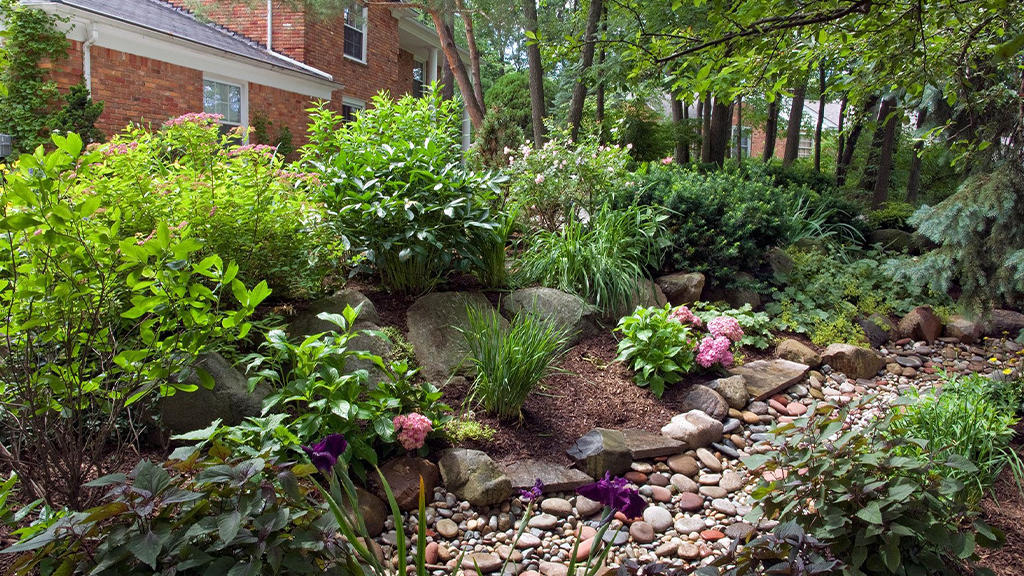Rain gardens are gaining popularity as a means of managing stormwater runoff in urban and suburban areas. By collecting and filtering rainwater, these gardens can help reduce flooding, erosion and pollution while creating a beautiful and sustainable landscape. When choosing plants for a rain garden, trees can play an important role in enhancing the aesthetics and functionality of the garden. Here are some of the best trees for rain gardens.
River Birch (Betula nigra): This deciduous tree is an excellent choice for rain gardens as it is very adaptable to wet conditions. It has attractive peeling bark and can grow up to 80 feet tall, providing shade and habitat for wildlife.

The best trees for rain gardens
Red Maple (Acer rubrum): Another deciduous tree that thrives in moist soil. Red maples are also known for their stunning fall foliage. They can grow up to 70 feet tall and provide excellent habitat for birds and other wildlife.
Serviceberry (Amelanchier spp.): This small, multi-stemmed tree produces white or pink flowers in spring and edible berries in summer. It tolerates moist soil and provides an excellent habitat for pollinators and songbirds.
Sweetbay Magnolia (Magnolia virginiana): This evergreen tree produces fragrant white flowers in summer and does well in moist soil. It grows up to 60 feet tall and provides habitat for a variety of wildlife species.
Bald Cypress (Taxodium distichum): This deciduous coniferous tree is known for its distinctive, ridged trunk and needle-shaped leaves that turn a rust-orange color in fall. It is highly adaptable to moist soil and can grow up to 30 feet tall.
Willow Oak (Quercus phellos): This deciduous tree produces slender, willow-like leaves and can grow to 80 feet tall. It tolerates moist soil and provides an excellent habitat for birds and other wildlife.
Black Gum (Nyssa sylvatica): Also known as Tupelo, this native deciduous tree has glossy, dark green leaves that turn bright red in fall. Black eucalyptus tolerates wet soil conditions and can grow up to 15 meters tall. It is an excellent choice for rain gardens as it provides habitat for a variety of wildlife including birds and pollinators.
American Hornbeam (Carpinus caroliniana): This small, slow-growing tree does well in moist soil and can reach 40 feet tall. It produces attractive, serrated leaves that turn yellow in fall and its bark is smooth and gray. American hornbeam is an excellent choice for rain gardens as it provides habitat for a variety of wildlife, including birds and butterflies.
Eastern Redbud (Cercis canadensis): This small, deciduous tree produces stunning pink or purple flowers in spring before it sprout its leaves. It does well in moist soil and can grow up to 30 feet tall. Eastern redbud is an excellent choice for rain gardens as it provides habitat for a variety of wildlife, including bees and butterflies.

Swamp White Oak (Quercus bicolor): This native deciduous tree is well adapted to moist soil and can grow to 100 feet tall. It produces attractive, lobed leaves that turn yellow or red in fall, and its bark is gray and deeply grooved. Swamp white oak is an excellent choice for rain gardens as it provides habitat for a variety of wildlife, including birds and mammals.
Witch Hazel (Hamamelis virginiana): This deciduous tree does well in moist soil and produces fragrant yellow or orange flowers in fall or winter. Witch hazel can grow up to 20 feet tall and provides excellent habitat for bees, butterflies, and other pollinators.
Sycamore (Platanus occidentalis): This fast-growing deciduous tree is very adaptable to moist soil and can grow up to 30 meters tall. It produces attractive, lobed leaves and provides excellent habitat for birds and other wildlife species.
American Elm (Ulmus americana): This native deciduous tree is highly adaptable to moist soil and can grow to 80 feet tall. It produces attractive, serrated leaves and provides excellent habitat for a variety of wildlife species including birds and squirrels.
The best trees for rain gardens
American Hornbeam (Carpinus caroliniana): This small, slow-growing tree does well in moist soil and can reach 40 feet tall. It produces attractive, serrated leaves that turn yellow in fall and its bark is smooth and gray. American hornbeam is an excellent choice for rain gardens as it provides habitat for a variety of wildlife, including birds and butterflies.
Eastern Redbud (Cercis canadensis): This small, deciduous tree produces stunning pink or purple flowers in spring before it sprout its leaves. It does well in moist soil and can grow up to 30 feet tall. Eastern redbud is an excellent choice for rain gardens as it provides habitat for a variety of wildlife, including bees and butterflies.
Swamp White Oak (Quercus bicolor): This native deciduous tree is well adapted to moist soil and can grow to 100 feet tall. It produces attractive, lobed leaves that turn yellow or red in fall, and its bark is gray and deeply grooved. Swamp white oak is an excellent choice for rain gardens as it provides habitat for a variety of wildlife, including birds and mammals.
Witch Hazel (Hamamelis virginiana): This deciduous tree does well in moist soil and produces fragrant yellow or orange flowers in fall or winter. Witch hazel can grow up to 20 feet tall and provides excellent habitat for bees, butterflies, and other pollinators.
Sycamore (Platanus occidentalis): This fast-growing deciduous tree is very adaptable to moist soil and can grow up to 30 meters tall. It produces attractive, lobed leaves and provides excellent habitat for birds and other wildlife species.
American Elm (Ulmus americana): This native deciduous tree is highly adaptable to moist soil and can grow to 80 feet tall. It produces attractive, serrated leaves and provides excellent habitat for a variety of wildlife species including birds and squirrels.
Hackberry (Celtis occidentalis): This deciduous tree is highly adaptable to moist soil and can grow up to 80 feet tall. It produces attractive, serrated leaves and provides excellent habitat for a variety of wildlife species including birds and butterflies.
Northern Red Oak (Quercus rubra): This deciduous tree is highly adaptable to moist soil and can grow to 75 feet tall. It produces attractive, lobed leaves that turn red in fall and provides excellent habitat for a variety of wildlife species including birds and mammals.

River Birch (Betula nigra): This deciduous tree is well adapted to moist soil and can grow to 90 feet tall. It produces attractive, flaky bark and provides excellent habitat for a variety of wildlife species, including birds and mammals.
Bald cypress (Taxodium distichum): This deciduous conifer does well in moist soil and can grow to 120 feet tall. It produces attractive, needle-like leaves that turn coppery brown in fall and provides an excellent habitat for a variety of wildlife species including birds and reptiles.
Sweetbay Magnolia (Magnolia virginiana): This evergreen or deciduous tree does well in moist soil and can grow up to 50 feet tall. It produces attractive, fragrant white flowers in spring and provides excellent habitat for a variety of wildlife species including bees and butterflies.
Red Maple (Acer rubrum): This deciduous tree is well-adapted to moist soil and can grow to 90 feet tall. It produces attractive, serrated leaves that turn red or yellow in fall and provides an excellent habitat for a variety of wildlife species, including birds and mammals.
Yellow Birch (Betula alleghaniensis): This deciduous tree does well in moist soil and can grow to 80 feet tall. It produces an attractive, yellowish-brown bark and provides excellent habitat for a variety of wildlife species, including birds and small mammals.
When planting trees in a rain garden, it is important to give each tree adequate space to grow and thrive. Trees should be spaced far enough apart to allow their roots to spread without competing for nutrients and water. By choosing the right trees and giving them the space and resources they need, you can create a healthy and vibrant rain garden that benefits both the environment and your community.


